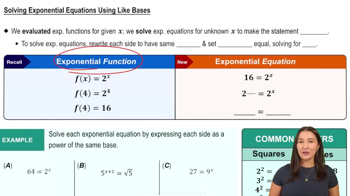Table of contents
- 0. Review of Algebra4h 16m
- 1. Equations & Inequalities3h 18m
- 2. Graphs of Equations43m
- 3. Functions2h 17m
- 4. Polynomial Functions1h 44m
- 5. Rational Functions1h 23m
- 6. Exponential & Logarithmic Functions2h 28m
- 7. Systems of Equations & Matrices4h 6m
- 8. Conic Sections2h 23m
- 9. Sequences, Series, & Induction1h 19m
- 10. Combinatorics & Probability1h 45m
6. Exponential & Logarithmic Functions
Solving Exponential and Logarithmic Equations
Problem 93a
Textbook Question
Solve each equation for the indicated variable. Use logarithms with the appropriate bases. See Example 10. y = A + B(1 - e^(-Cx)), for x
 Verified step by step guidance
Verified step by step guidance1
Start by isolating the exponential term: subtract A from both sides to get y - A = B(1 - e^{-Cx}).
Divide both sides by B to isolate the exponential expression: \( \frac{y - A}{B} = 1 - e^{-Cx} \).
Rearrange the equation to isolate the exponential term: \( e^{-Cx} = 1 - \frac{y - A}{B} \).
Take the natural logarithm of both sides to solve for \(-Cx\): \( -Cx = \ln\left(1 - \frac{y - A}{B}\right) \).
Finally, solve for \(x\) by dividing both sides by \(-C\): \( x = -\frac{1}{C} \ln\left(1 - \frac{y - A}{B}\right) \).
Recommended similar problem, with video answer:
 Verified Solution
Verified SolutionThis video solution was recommended by our tutors as helpful for the problem above
Video duration:
6mPlay a video:
Was this helpful?
Key Concepts
Here are the essential concepts you must grasp in order to answer the question correctly.
Exponential Functions
Exponential functions are mathematical expressions in which a constant base is raised to a variable exponent. In the equation provided, e^(-Cx) represents an exponential decay function, where 'e' is the base of natural logarithms. Understanding how these functions behave is crucial for manipulating and solving equations involving them.
Recommended video:

Exponential Functions
Logarithms
Logarithms are the inverse operations of exponentiation, allowing us to solve for the exponent in equations. When dealing with equations like y = A + B(1 - e^(-Cx)), logarithms help isolate the variable x by transforming the exponential part into a linear form. Familiarity with properties of logarithms, such as the change of base formula, is essential for solving such equations.
Recommended video:

Logarithms Introduction
Isolating Variables
Isolating a variable involves rearranging an equation to solve for that specific variable. In the context of the given equation, this means manipulating the equation step-by-step to express x in terms of the other variables. Mastery of algebraic techniques, such as addition, subtraction, multiplication, and division, is necessary to effectively isolate the desired variable.
Recommended video:
Guided course

Equations with Two Variables

 4:46m
4:46mWatch next
Master Solving Exponential Equations Using Like Bases with a bite sized video explanation from Callie
Start learningRelated Videos
Related Practice













